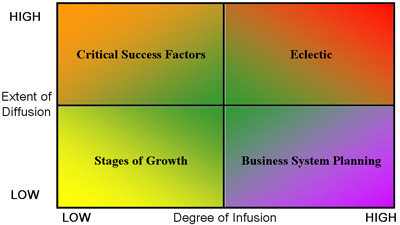IT Planning

Introduction
Strategies define the broad course of action for an organization in terms of objectives, and provides insights into how they will be achieved.
Strategies do not provide many details! They establish the desired target, and provide general directions for achieving it.Developing a detailed roadmap (to the target) is called planning.
Various plans provide specific detail on how to reach goals and achieve objectives. Together, strategy and planning documents record and communicate the organization’s intentions.
Planning starts with strategic plans based upon strategy statements, and continues through tactical planning to the development of detailed operational plans and controls.
IT planning combines for linked stages:
- Agreement on the future business vision and technology opportunity.
- Development of business ideas for IT applications.
- Business and IT planning for applications and architectures.
- Successful use of the business and IT plans.
The Planning Horizon
There are 3 broad classifications of plans – strategic, tactical and operational plans. The time span that is typical for each class of planning is the planning horizon.The planning horizon for operational plans may be 1 to 3 months, whereas tactical plans generally extend between 12 months and 2 years. Strategic plans can extend for many years.

Strategic plans represent the long-term implementation of strategies, often covering the period 2-5 years into the future – the extended planning horizon. They contain specific details for achieving the organization’s mission and key goals and objectives. They form the basis for operational plans.
Tactical plans typically span the period of 3 months to 2 years into the future. Therefore they provide a bridge between strategic and operational plans.
Strategic Planning
Strategic planning converts strategies to plans. Derived from the strategy statement, it adds detailed actions, allocates resources, and resolves the risks, assumptions and dependencies found within the strategy. The outcome are action plans to achieve the goals and objectives.
The strategic IT plan includes financial information associated with IT costs and expenses. This plan is detailed enough to be tracked over its lifetime by comparing planned to actual performance.
Example
The IT group of a manufacturing company, wishing to achieve improved market response, has a strategy of installing CAD/CAM systems for its design and development engineers, and manufacturing plant. The systems are to be effective in 48 months.
The strategy statement contains assumptions for using CAD/CAM and outlines dependencies and risks (E.g. resistance to new systems may be a risk).
The strategic plan adds details of schedule, actions, and resources: space requirements for equipment, training for users, capital resources, and operating expenses. The plan states that space will be leased, and that training will be provided to overcome any resistance to the new systems.
Tactical Plans
Tactical planning generally covers the current year in detail, and extends to the next year in less detail.These plans can be the basis of managers’ implementation commitments, and may be used to measure their performance, and so can be called measurement plans.
Tactical plans contain more detail and relate directly on operational activities. They guide these very short-term activities and link them to the longer-term strategic goals.
Example
In the CAD/CAM Case, many activities will be planned in the first 2 years. These include: selecting hardware and software, installing hardware and software, training users and IT people, converting from previous processes to new procedures, and establishing measurement systems.
Questions must be answered: “From whom will the space be leased?”, “Where will it be located?”, and ‘What type of training is needed to overcome user resistance?”.
Managers must schedule these activities, assign resources, and develop detailed budgets. Implementing managers must commit to the plan and be evaluated upon its attainment.
Operational Plans and Controls
The operational plans add detail and direction to the organization’s activities on a day-to-day and/or a week-to-week basis.
Line managers and supervisors use operational plan as they carry out their responsibilities. Operational plans usually require more detailed analysis that the longer-termed plans, and must also contain detailed controls. They can be used for schedule analysis between planned and actual results to show managers if these activities are on schedule – i.e. project control and tracking.
Example
The CAD/CAM installation contains many operational tasks. These include the identification of hardware and software vendors, setting vendor selection criteria, developing floor space alternatives, and undertaking analysis of the current operating-manufacturing procedures.
Also the management tasks of planning for future short-term goals, budgeting, and cost and schedule tracking continues.
Planning Schedules
In most organisations planning is a regularly scheduled event closely linked to the corporate fiscal calendar. Furthermore, it is common practice to develop tactical plans so they can be approved just before the tactical period begins.
So, for a business operating on the calendar year, this means that the tactical plan is developed and approved in the few months before the new year begins. The organization begins the the new year under the control of a new tactical plan that extends to the second year, which has an associated strategic plan extending 5 (or more) years into the future.
Organisations with well-established planning processes do not start planning at the start of each iteration, rather the new tactical plan revises the second year of the old plan, and adds to it the first year of the old strategic plan. The new strategic plan is a revision of the last years of the old plan, with a new year added. The revisions reflect changes to strategies, business conditions and operating environment, and failure at achieve goals and objectives.

A Model for IT Planning
Given that planning must consider not only strategy, goal and objectives, but also constraints, ambiguities, facts, and uncertainties, what planning procedures might best serve the IT function? What kind of activities need to be planned? What tools and information assist the task of IT planning?
A complete IT plan developed from rigorous process answers these questions. An effective plan is a detailed and thoughtful document describing actions for implementing strategy over the planning period.
The plan must address line and staff responsibilities of IT –the following components being critical for success:
- Application considerations – of the application programs used to conduct business.
- Systems operations –the processes and key elements for running the business’s applications.
- Resource plan – especially the description of critical dependencies.
- Administrative actions – that assist planning.
- Technology planning – monitoring future directions.
Model - Application Considerations
The applications portfolio consists of the complete set of application programs the company uses to conduct its automated business functions. Managing applications assets is a very difficult task, and planning for this activity must be conducted with skill.
The plan for dealing with these applications must incorporate the selection and project management – scheduling, tracking, control and evaluation – of all projects to be implemented during the planning period. Resources required for development, enhancement, maintenance and implementation must also be planned.
Identifying systems for enhancement or acquisition to support new strategies or altered business activities can be difficult. The plan must justify the action, describe why the action is necessary, and name who is responsible for taking the action.
Managers must know the answers to “who, what, when, where, why and how” for all planning activities. Considering these questions when planning for applications provides the basis for controlling plan implementation and for monitoring deviations from it. Therefore all the plans must contain controls.
Model – System Operations
System operations consist of the processes for running a business’s application. These processes may be continuous online systems, networked client/server systems, periodic, scheduled systems, or combinations are variations of these systems.
IT Managers must plan system operations to satisfy customers within the organization and outside it. IT must have a plan to satisfy customers expectations about the IT service they receive.
Planning service levels is very important in systems operations.
The essential management activities for ensuring the service levels, and the key elements for a systems operations plan are:
- Service level planning
- Problem management
- Change management
- Recovery management
- Capacity planning
- Network planning
Model – Resource Planning
The IT plan needs to describe the critical dependence on available resources throughout the planning horizon. The main resources associated with IT are money, equipment, people, space and technology.
In addition the IT plan must include network equipment and services such as switches, routers, and other costs. The organization’s financial obligations consist of purchase and lease costs, and expenses for third-party services.
The key elements commonly found in the resource section of a plan are:
- Equipment plans
- Space plans
- People plans
- Financial plans
- Administrative plans
Note that technology is a resource that is considered separately in the IT plan.
Model – People Plans
An essential part of the IT resource plan is people – an essential element in any plan. Therefore the plan for the effective management of people resources must be well thought through and developed.
These plans need to identify the IT requirements for human resources according to skill level, and their development and deployment over the extended planning horizon. It must also address hiring, training and retraining, and include individual development plans.
Model – Financial Plans
This part of the IT resource plan summarises the costs associated with equipment, space, people, and other miscellaneous expenses.
An organisation’s code of accounts will segregate and identify the specific costs and expenses. When the IT plan is approved, the budget for the planning years is constructed by funding the various accounts to the level the plan requests.
Model – Administrative Actions
Throughout the planning cycle many administrative actions assist in the planning process and in the implementation of the IT plan. Before beginning, the planners formulate a set of assumptions and ground rules. This is formalised as a list of assumptions and ground rules, and helps to ensure that the resulting plan reasonable, relevant and feasible.
When planning, IT Managers must obtain the cooperation of managers in adjacent functional areas and coordinate the emerging plans. All the planners must use administrative processes to ensure complete and unambiguous communication.
To improve IT planning effectiveness, many companies establish steering committees consisting of representatives from the functional areas. The purpose of these committees is to guide the IT planning and investment process. Active steering committees increase the mutual understanding of users and IT personnel, and tend to increase and improve executive involvement in IT matters.
Steering committees, consisting of senior executive from all parts of the business, provide valuable assistance in ensuring plan synchronisation between IT and the rest of the organization. This is especially valuable in organisations with widely dispersed, decentralised IT operations.
Model – Technology Planning
The IT organization has a continuing responsibility to keep a watching brief on technological advances, and inform the company of relevant advances in the field. Senior professionals throughout the IT organization must keep up-to-date with advances in their specific areas of interest.
Programming managers must track advances in programming technology, and system support personnel and telecommunications experts must maintain a current awareness of the technology, and improve their expertise.
Some of the many technological fields that should be evaluated as part of the planning process include:
- New processor developments
- Advances in storage technology
- Telecommunications systems
- Operating systems
- Communication software
- Programming tools
- Vendor application software
- Systems management tools
Other Approaches to Planning
Other approaches to planning that are relevant to IT planning include:
- Stages of Growth – where stage theory is used to assess the current posture of the organisation.
- Critical Success Factors – particularly used to audit results of the planning process to ensure the plan contains the conditions necessary for success.
- Business Systems Planning – a process that identifies the organisations key activities , and the systems and data that support these activities. Note that this “bottom-up” approach is very detailed and time-consuming.
The Integrated Approach
Cornelius Sullivan studied 37 major USA companies to better understand the effectiveness of their planning systems within the context of factors within each organization. Sullivan found that two factors correlate with planning effectiveness:
- Infusion – the degree to which IT has penetrated the business’s operations (depth of IT).
- Diffusion – the extent to which IT is disseminated throughout the business (breadth of IT distribution).
The results were tabulated on the IT Planning Environments matrix.

As shown by this matrix, Stages of Growth does not suit most IT organisations. Critical Success Factors are useful where IT is dispersed and of moderate impact. Business Systems Planning is more effective where IT is centralized and has a high impact.
However, many IT organisations are in the Eclectic quadrant and are faced with a complex planning process because their IT operations are very complex. They are faced with the question – “What planning methodology best suits the organisation in the Eclectic quadrant?”
The Integrated Approach is an organisational approach where planning consists of frequent interchanges between the IT function and client functions to develop projects that lead to shared outcomes. Functional interactions occur on an as-needed basis, and supplement other long-range planning activities.
This allows planning to take place while fast-paced transformations occur within the functions of the business. This planning approach selects what is needed, when it is needed, and suits the eclectic environment.
Management Feedback
Control is all about management feedback – knowing the who, what, when, where, why, and how for all the organization’s activities.
Managers who know these answers operate under control, and those who don’t are out of control!
An out-of-control IT organization causes very serious difficulties for its managers and the business. Control is vital not only to an IT organization’s success, but to the entire business because IT is so important to so many parts of the business.
Conclusion
Some important points to remember:
Plans are only as good as their implementation and control mechanisms.
Control is a fundamental management responsibility – especially important to people managing volatile, rapidly changing environments.
IT planning is a necessary condition and a critical success factor for IT managers.
What do you know? What do you need to know?
For review questions - this is your chance to discuss answers with your lecturer.


